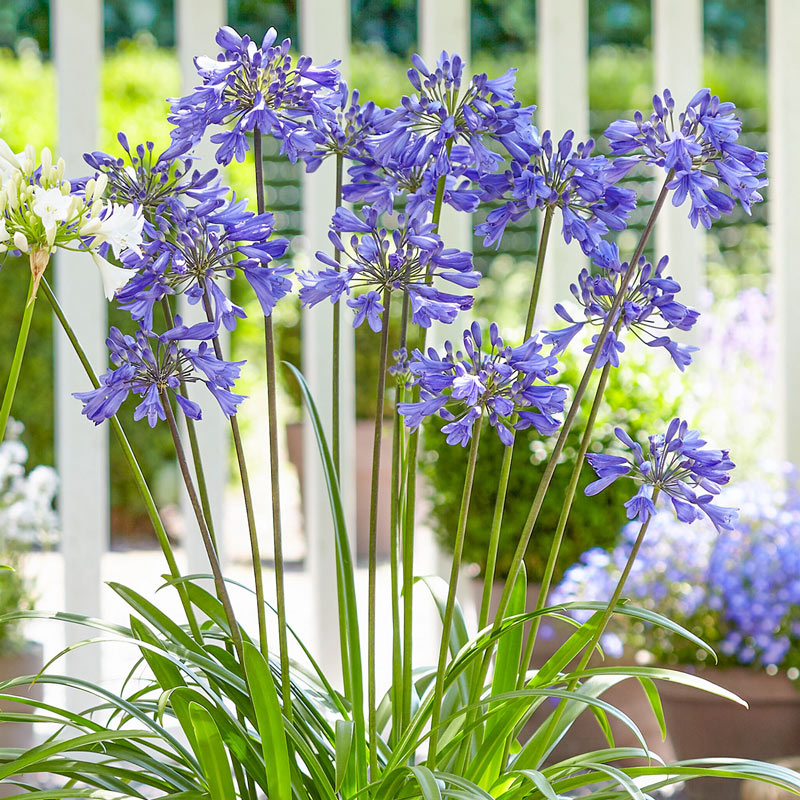Agapanthus Buddy Plant Kingdoms: Perfect Pairings for Your Garden
Agapanthus Buddy Plant Kingdoms: Perfect Pairings for Your Garden
Blog Article
Understanding the Art of Agapanthus Care: Necessary Steps for Healthy Growth and Vivid Blossoms
In the world of horticulture, the farming of agapanthus stands as a gratifying endeavor for those that seek to support these elegant flowering plants. With their striking flowers and graceful foliage, agapanthus has recorded the interest of garden enthusiasts worldwide. Nonetheless, accomplishing optimal growth and vibrant blooms needs a nuanced technique that includes various necessary actions. From selecting the ideal variety to grasping pruning techniques, the trip towards growing thriving agapanthus plants is complex and holds the vital to unlocking the full possibility of these agricultural treasures.

Choosing the Right Agapanthus Selection

When choosing the ideal Agapanthus variety for your yard, think about variables such as climate suitability, flower color, and development habit. Agapanthus, commonly called Lily of the Nile or African lily, can be found in a range of colors varying from tones of purple and blue to white. Pick a blossom color that complements your existing yard palette to produce a harmonious landscape. In addition, consider the environment in your area to make sure the Agapanthus range you choose can flourish in your specific problems. Some selections are extra forgiving of cool temperatures, while others like warmer environments. Recognizing the development behavior of different Agapanthus ranges is crucial for proper placement within your yard. Some selections have a clumping development behavior, suitable for borders or containers, while others have an even more spreading nature, ideal for ground cover or mass growings. By meticulously examining these factors, you can pick the best Agapanthus range to enhance the elegance of your yard.
Ideal Growing Problems
Considering the optimal environmental needs is vital for effective Agapanthus growing. Agapanthus plants are delicate to chilly temperatures and need to be shielded from frost throughout winter season months.
To make sure healthy and balanced growth and lively blooms, plant Agapanthus light bulbs at a depth of regarding 2-4 inches and room them 8-12 inches apart. Including raw material, such as garden compost, to the dirt can improve drainage and fertility, advertising robust origin growth. Mulching around the base of the plants aids preserve wetness and reduces weed growth. Routine watering is crucial, specifically throughout the expanding period, to maintain the dirt continually damp but not saturated.
Watering and Feeding Tips
Keeping correct wetness levels and supplying crucial nutrients are vital aspects in the care program for Agapanthus plants. It is critical to strike an equilibrium when it comes to watering Agapanthus. These plants prefer continually damp soil but are at risk to root rot if overwatered. During the growing season, water deeply as soon as a week, making certain the dirt is well-draining to stop waterlogging. In hotter climates or during periods of drought, even more constant watering may be required to keep the soil evenly moist. Nonetheless, decrease watering in the winter to stop waterlogged problems.
Fertilizing Agapanthus is important for promoting healthy and balanced development and wikipedia reference respected blossoms. Use a balanced plant food, such as a 10-10-10 formula, in the very early spring as brand-new growth arises. By following these watering and fertilizing ideas, you can guarantee your Agapanthus plants prosper and create vivid, lasting flowers.
Pruning Techniques for Agapanthus
Pruning Agapanthus plants at the appropriate times and with correct methods is vital for keeping their health and wellness and advertising ideal growth and blooming. The excellent time to trim Agapanthus is in late winter or very early spring before brand-new growth arises.
Deadheading spent flowers can additionally redirect the plant's energy into creating even more blooms instead than establishing seeds. If you want to gather seeds for breeding, leave some blossoms to completely dry and mature on the plant.
Keep in mind to utilize clean, sharp tools to make specific cuts and reduce the danger of introducing conditions. Agapanthus. Routine trimming will certainly aid keep your Agapanthus looking cool and healthy and balanced while making certain an abundant display screen of gorgeous flowers
Managing Usual Parasites and Diseases
After making certain appropriate pruning strategies for Agapanthus, it is important to attend Web Site to usual bugs and conditions that can affect the health and wellness and vigor of these plants. One usual bug that impacts Agapanthus is the Agapanthus gall midget.
Furthermore, Agapanthus plants can suffer from origin rot if they are planted in improperly draining pipes soil. By being watchful and taking prompt action versus conditions and pests, you can help your Agapanthus plants grow and generate vivid blooms. Agapanthus.
Conclusion
In conclusion, understanding the art of agapanthus care involves choosing the ideal variety, giving excellent growing problems, appropriate watering and fertilizing, ideal trimming techniques, and attending to common insects and conditions. By complying with these vital steps, you can ensure healthy development and dynamic flowers for your agapanthus plants. Keep visit in mind to regularly monitor and maintain your plants to advertise their general wellness and longevity.
To make certain healthy and balanced development and vivid flowers, plant Agapanthus bulbs at a depth of concerning 2-4 inches and area them 8-12 inches apart. By complying with these watering and feeding pointers, you can guarantee your Agapanthus plants flourish and generate vivid, durable flowers.
One common parasite that impacts Agapanthus is the Agapanthus gall midget. In addition, Agapanthus plants can suffer from root rot if they are grown in inadequately draining pipes soil. By adhering to these vital steps, you can ensure healthy and balanced growth and lively flowers for your agapanthus plants.
Report this page